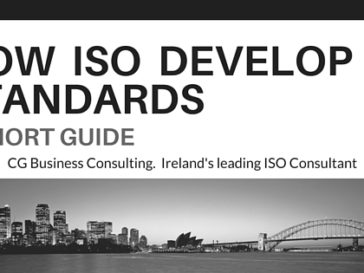Meet the new CGBC Graduates
Welcome to CG Business Consulting, where passion meets purpose, and ISO and sustainability takes centre stage!

In today’s blog we go through the basics of the three most popular ISO Standards:
ISO 9001, ISO 14001, and ISO 45001. No fuss, no frills, just facts.
ISO 9001 is the world-renowned international standard for Quality Management Systems (QMS). A process-based framework, it was designed to ensure that organisations can meet if not exceed customer needs whilst simultaneously achieving optimal product and service excellence. By mandating its adoptees to adhere to rigorous requirements it also ensures statutory and regulatory compliance.
Driven by the requisite of continuous improvement, ISO 9001 underpins competitiveness, growth, reputation and of course, Quality of the highest standard.
The benefits of ISO 9001 are manifold and include:
Customer opinion is central to the success or failure of any business. Where an organisation is constantly hitting service delivery KPIs it is guaranteed high levels of customer satisfaction leading to enhanced reputation, and consequentially, growth.
By integrating and simplifying business processes, ISO 9001 transforms operations into a more straightforward and transparent function that minimises the risk of error and maximises the opportunity for excellence and success.
Working in a busy environment can often be confusing, time consuming and tiring. By offering employees more streamlined work practices an organisation stands to benefit from improved performance resulting in increased productivity and worker fulfilment. Implementing a QMS will result in a significant number of benefits to your employees that will help to boost the growth and success of your company.
Prior to entering this process, the organisation must implement a Quality Management System which must be operational for three months. The QMS must also have undergone a rigorous management review as well as a thorough internal audit. On successful completion of the audit process, certification is issued by an approved body.
As continuous improvement is a key prerequisite of ISO 9001, annual reviews or audits must be carried out to mitigate against risk, identify opportunity and maintain efficacy and excellence.
Due to their having the same design template, most ISO Standards allow for quick and seamless integration including ISO 9001. This easy interoperability means ISO 9001 Quality Management System Standard is compatible with the most popular system standards - ISO 14001, 45001, 50001 & more.
The QMS is an all-encompassing system, the benefits of which are tightly interwoven. In improving business workflow, employee engagement is increased, which in turn positively impacts worker performance resulting in optimum customer experience.
For more information on ISO 9001, read our articles ISO 9001 and Change Management and Quality - You Get What You Pay For.
Check out our Iso 9001 article
ISO 14001 is the leading Environmental Management System (EMS) standard designed to reinforce environment-driven operations and strategies in organisations of all shapes and sizes. Its main objective is to help organisations to achieve sustainability- and ultimately net zero - by adopting eco-friendly business operations.
The benefits of ISO 14001 are extensive and include:
In a world of increasing environmental instability that has seen dramatic growth in awareness of everything from global warming to wildlife extinction, consumers are more eco-conscious than ever before.
An organisation that can wear its green credentials on its marketing, advertising, and PR sleeves, is one which will maintain if not increase market share.
At a time when it is vital that a business can publicise its commitment to the environment, there is no greater mark of dedication to sustainability than ISO 14001.
By mandating organisation to work to a set of rigorous compliance-driven requirements, ISO 14001 helps them achieve statutory and regulatory compliance - local, national and EU.
It can also support the organisation in its commitment to meeting internal as well as national targets, such as those outlined in the government’s Climate Action Plan 2021 and Net Zero 2050 policy.
An organisation can achieve optimal environmental performance through adopting the best practice processes and working to the stringent requirements of the EMS including:
• Effective waste and water management.
• Ability to correctly assess the environmental impact to reduce carbon footprint.
• Working to the RRR methodology - Reduce, Reuse, Recycle.
• Increased employee awareness of and engagement with eco-friendly best practices.
• Rolling out environmentally friendly changes across the board from appliances to stationery to canteen supplies.
Like the QMS, the Environmental Management System can successfully operate as a standalone system or as a blended element of a multi-standard integrated system. Likewise, certification to ISO 14001 follows the same two-step review process and mandatory annual audits.
ISO 14001 reflects the seismic shift in our attitudes towards nature and the environment, how we live in and integrate with it, how we care and respect for it, and how we can protect it now and for the future. For these and many more reasons, ISO 14001 can help an organisation to play a significant - and expected - part in the movement for a Green Planet.
Interested in Sustainability? Check out our article on "How Irish Businesses are Working to a More Sustainable Future"
The most widely adopted OH&S best-practice system in the world, ISO 45001 is a robust framework against which an organisation can plan, build, and continuously improve its workplace ergonomic and health and safety policies, processes and procedures. It was specifically designed by OH&S experts to optimise an organisations ability to minimise the risk of workplace injury and hazard whilst simultaneously enabling it to create a better working environment.
The many benefits of working to ISO 45001 include:
By providing the organisation with clear risk-based guidance on managing occupational health and safety, ISO 45001 can help it achieve a risk-free working environment through the roll-out of safety-driven policies that mitigate against accidents and incidents such as spillages, leakages, faulty machinery, or loose wiring which can often result in employee injury.
In today’s employees’ market, it is vital that any prospective employer can prove its commitment to worker health and safety if it is to attract the calibre of personnel it requires to maintain and grow the business.
Being certified to ISO 45001 is a public declaration of intent that can help build confidence, gain trust and earn the respect of prospective employees as well as existing and new customers.
By providing a clean and safe working environment, an organisation is sending out a clear signal that it is dedicated to doing what it can to support a healthy workforce.
Organisations that invest in robust Health and Safety management benefit from a hefty ROI in the form of reduced costs and improved performance and productivity that drive increased efficiencies and profits.
A workplace that is sanitary, safe, and secure is guaranteed to ensure the organisation suffers minimal costs associated with work-related accidents. It will also avoid unwanted high-profile reporting on related court cases which can severely impact business through damaged reputation.
Employees who are confident in their working environment and the equipment they must use to perform their daily tasks are more likely to display increased productivity and improved performance than those attempting to carry out their duties in unsafe, poorly laid out or ill-equipped environments.
If you are considering a review of your existing OH&SMS - Occupational Health and Safety Management System - or planning to implement one, CG Business Consulting can offer invaluable guidance and support via a dedicated ISO Consultant experienced in the H&S space.
We offer tailor-made service offerings that can help you identify gaps and risks across the organisation. From the office floor to chemical storage systems, CG Business Consulting’s specialist consultant will work with your organisation to achieve a custom management system that delivers the results your business and workforce need.
As with the QMS and EMS, the Occupational Health and Safety Management System is integrable with other management systems whilst certification to ISO 45001 follows the same two-step review process and mandatory annual audits.
Workplace Health and Safety is important across all industries but especially so in the Construction, Engineering, Manufacturing and Pharma sectors.
Our Workplace Health and Safety 101 is a must read for anyone planning to review management of OH&S while our article on Construction Needing Robust H&S Policy deep dives into the problems facing Building, Construction & Engineering firms.
If your organisation is considering getting certified in ISO 9001, 14001 and/or 45001, CG Business Consulting offers a full suite of ISO-related services including accredited ISO Certification Awareness & Audit Training, Gap Analysis and Performance Reviews.
All our services are in line with ISO management system requirements and are delivered by our team of experienced consultants, subject matter expects in their dedicated fields.
CG Business Consulting is a compliance-centric ISO service provider committed to ensuring our clients achieve certification and effective implementation with minimum downtime and effort resulting in maximum results.
For more information on our ISO services, contact Rob on email hello@cgbc.ie or by phone at 01- 620 4121. We look forward to working with you towards a better future.

Welcome to CG Business Consulting, where passion meets purpose, and ISO and sustainability takes centre stage!

In an ever-evolving market, businesses need to constantly adapt and improve to stay ahead of the curve. One of the most valuable exercises any...

The International Standards Organisation explains how they develop a new ISO standard An ISO standard is developed by a panel of experts, within a ...